Experimental Study on Flexural Resistance of UHPC Wet Joint Precast Reinforced Concrete Bridge Deck Slabs with Variable Cross-Section
Abstract
:1. Introduction
2. Experiment Overview
2.1. Engineering Background and Specimen Description
2.2. Model Loading and Test Procedure
3. Experimental Results Analysis
3.1. Load-Displacement Curve
3.2. Load-Strain
3.3. Development and Distribution of Concrete Cracks
3.4. Destruction Mode
4. Numerical Modelling and Analysis
4.1. Establishment of Numerical Analysis Model
4.2. Selection of Material Constitutive Models
4.2.1. Concrete Constitutive Model
4.2.2. Reinforcing Steel Constitutive Model
4.3. Analysis of Numerical Calculation Results
5. Conclusions
- (1)
- During loading, cracking initially occurred at the interface between new and old concrete of the wet joint, with a maximum crack width of 0.24 mm. As the load increased, minor cracks appeared on both sides of the wet joint, and cracking occurred at the bottom of the deck at the loading location, with a maximum crack width of 0.34 mm. The specimen ultimately failed near the variable cross-section location adjacent to the wet joint. The initial cracking load was 0.27 times the failure load (225 kN), with a failure load of 822 kN, and the maximum displacement was 21.64 mm.
- (2)
- Apart from the interface between new and old concrete, no cracks appeared at other locations of the wet joint, indicating that the use of UHPC wet joints with variable cross-section bridge decks significantly improves crack resistance under negative bending moments, meeting design requirements with good mechanical performance. The most critical position for wet joint failure in variable cross-section bridge decks is at thinner deck thicknesses and their variable cross-section locations.
- (3)
- In contrast to the failure pattern of uniform cross-section bridge decks, where failures often occur at wet joint locations, the failure mode of variable cross-section precast reinforced concrete bridge decks with UHPC wet joints involves flexural–shear failure near the variable cross-section of the wet joint. Vertical cracks initiate at the bottom of the deck and propagate upwards, evolving into diagonal cracks. From a lateral view, a major diagonal crack rapidly forms and extends to the edge of the load-bearing pad, ultimately resulting in the concrete specimen tearing into two parts and losing its load-bearing capacity.
- (4)
- Displacement variation computed by the finite element model closely matches experimental results: both exhibit similar ultimate bearing capacities and ultimate displacements, with errors not exceeding 10%. Moreover, both follow similar load-displacement variation patterns, divisible into three stages. Employing the plastic damage model of concrete materials in ABAQUS software effectively identifies the position of plastic damage in the model. While this model cannot precisely pinpoint crack locations, it aids in determining damage locations and predicting the formation and propagation of cracks, with simulated concrete damage locations closely resembling experimental crack initiation and failure locations.
Author Contributions
Funding
Institutional Review Board Statement
Informed Consent Statement
Data Availability Statement
Acknowledgments
Conflicts of Interest
References
- Deng, S.; Shao, X.; Yan, B.; Guan, Y. Fully prefabricated rapid erection steel-UHPC lightweight combination urban bridge. Natl. Highw. J. 2017, 30, 159–166. [Google Scholar]
- Zhang, Q.; Cai, S.; Wang, S.; Wang, L.; Zhai, J. Flexural test analysis of steel-UHPC combined beams in negative moment zone. Munic. Technol. 2020, 38, 41–45. [Google Scholar]
- Zhang, Y.; Cao, S.; Ye, P.; Chen, J.; Tian, H. Experimental study on mechanical properties of U-shaped steel wet joints in steel plate girder bridges. China Munic. Eng. 2019, 5, 95–97. [Google Scholar]
- Zhang, Y.; Chen, B. Finite element analysis study on flexural performance of cast-in-place UHPC joints of prefabricated NC slab. Highw. Eng. 2018, 43, 1–5+51. [Google Scholar]
- Zhong, Y.; Wu, F.; Dai, L. Flexural performance test of ultra-high performance concrete beams with wet joints. Water Transp. Eng. 2020, 41–46. [Google Scholar]
- Zhang, P.; Hu, R.; Zou, X.; Liu, Y.; Li, Q.; Wu, G.; Sheikh, S.A. Experimental study of a novel continuous FRP-UHPC hybrid beam. Compos. Struct. 2021, 261, 113329. [Google Scholar] [CrossRef]
- Perry, V.H.; Royce, M. Innovative Field Cast UHPC Joints for Precast Bridge Decks. In Proceedings of the 2010 Concrete Bridge Conference; Achieving Safe, Smart & Sustainable Bridges, Phoenix, AZ, USA, 24–26 February 2010; Nation Concrete Bridge Concil: Phoenix, AZ, USA, 2010; pp. 197–213. [Google Scholar]
- Carbonell, M.A.; Harris, D.H.; Shann, S.V.; Ahlborn, T.M. Bond strength between UHPC and normal strength concrete (NSC) in accordance with split prism and freeze-thaw cycling tests. In Proceedings of the 3rd International Symposium on UHPC and Nanotechnology for High Performance Construction Materials, Kassel, Germany, 7–9 March 2012; pp. 377–384. [Google Scholar]
- Yuan, J.; Jia, Y.; Yan, B. Study on flexural performance of rectangular UHPC wet joints. Highw. Eng. 2020, 45, 129–134. [Google Scholar]
- Zhou, R. Study on the force characteristics of wet joints of prefabricated bridge decks. Shanghai Highw. 2020, 2, 73–78. [Google Scholar]
- Zhu, Y.; Ding, D. Research on lap length of ring reinforcement in wet joints of precast concrete beams. Highway 2015, 60, 89–93. [Google Scholar]
- Tian, F. Structural Performance and Experimental Study of Continuous Girder Bridge with Steel-Precast Concrete Slab Combination. Master’s Thesis, Southeast University, Nanjing, China, 2016. [Google Scholar]
- Su, Q.; Hu, Y.; Tian, L.; Zeng, M. Arc-shaped reinforcement connection structure for wet joints of combined girder bridge deck slabs. Chin. J. Highw. 2017, 30, 86–92. [Google Scholar]
- Cao, S.; Zhang, Y.; Ma, Q.; Ma, R.; Tian, H. Experimental study on mechanical properties of transverse U-bar wet joints in steel plate composite girder bridges. Bridge Constr. 2020, 50, 70–75. [Google Scholar]
- Zhao, C.; Wang, K.; Zhou, Q.; Deng, K.; Cui, B. Full-Scale Test and Simulation on Flexural Behavior of Dovetail-Shaped Reactive Powder-Concrete Wet Joint in a Composite Deck System. J. Bridge Eng. 2018, 23, 04018051. [Google Scholar] [CrossRef]
- Di, J.; Han, B.; Qin, F. Investigation of U-bar joints between precast bridge decks loaded in combined bending and shear. Structures 2020, 27, 37–45. [Google Scholar] [CrossRef]
- Yao, Z.; Yan, B. Research on model test and bending performance of assembled UHPC bridge with wet joint. Highw. Eng. 2020, 45, 105–110, 138. [Google Scholar]
- Shao, X.; Chen, B.; Zhou, X. Wet joint bending test of steel-RPC lightweight combination bridge deck structure. Chin. J. Highw. 2017, 30, 210–217. [Google Scholar]
- Ramezani, M.; Dehghani, A.; Sherif, M.M. Carbon nanotube reinforced cementitious composites: A comprehensive review. Constr. Build. Mater. 2022, 315, 125100. [Google Scholar] [CrossRef]
- Shang, X.Y.; Yu, J.T.; Li, L.Z.; Lu, Z.D. Strengthening of RC structures by using engineered cementitious composites: A review. Sustainability 2019, 11, 3384. [Google Scholar] [CrossRef]
- Shen, Y.; Guo, W.; Han, Z.; Fan, T. Experimental study on pure bending damage behaviour of concrete bridge deck slabs with wet joints. Bridge Constr. 2019, 49, 34–39. [Google Scholar]
- Zhang, J.; Huang, S.; Guan, Z. Static load test of longitudinal U-bars of prefabricated small box girder with staggered lap joints. Chin. J. Highw. 2018, 31, 115–123. [Google Scholar]
- Hussein, H.H.; Walsh, K.K.; Sargand, S.M.; Al Rikabi, F.T.; Steinberg, E.P. Modeling the Shear Connection in Adjacent Box-Beam Bridges with Ultrahigh-Performance Concrete Joint. I: Model Calibration and Validation. J. Bridge Eng. 2017, 22, 04017043. [Google Scholar] [CrossRef]
- GB50010-2010; Code for Design of Architecture & Concrete Structures. China Architecture & Building Press: Beijing, China, 2010.



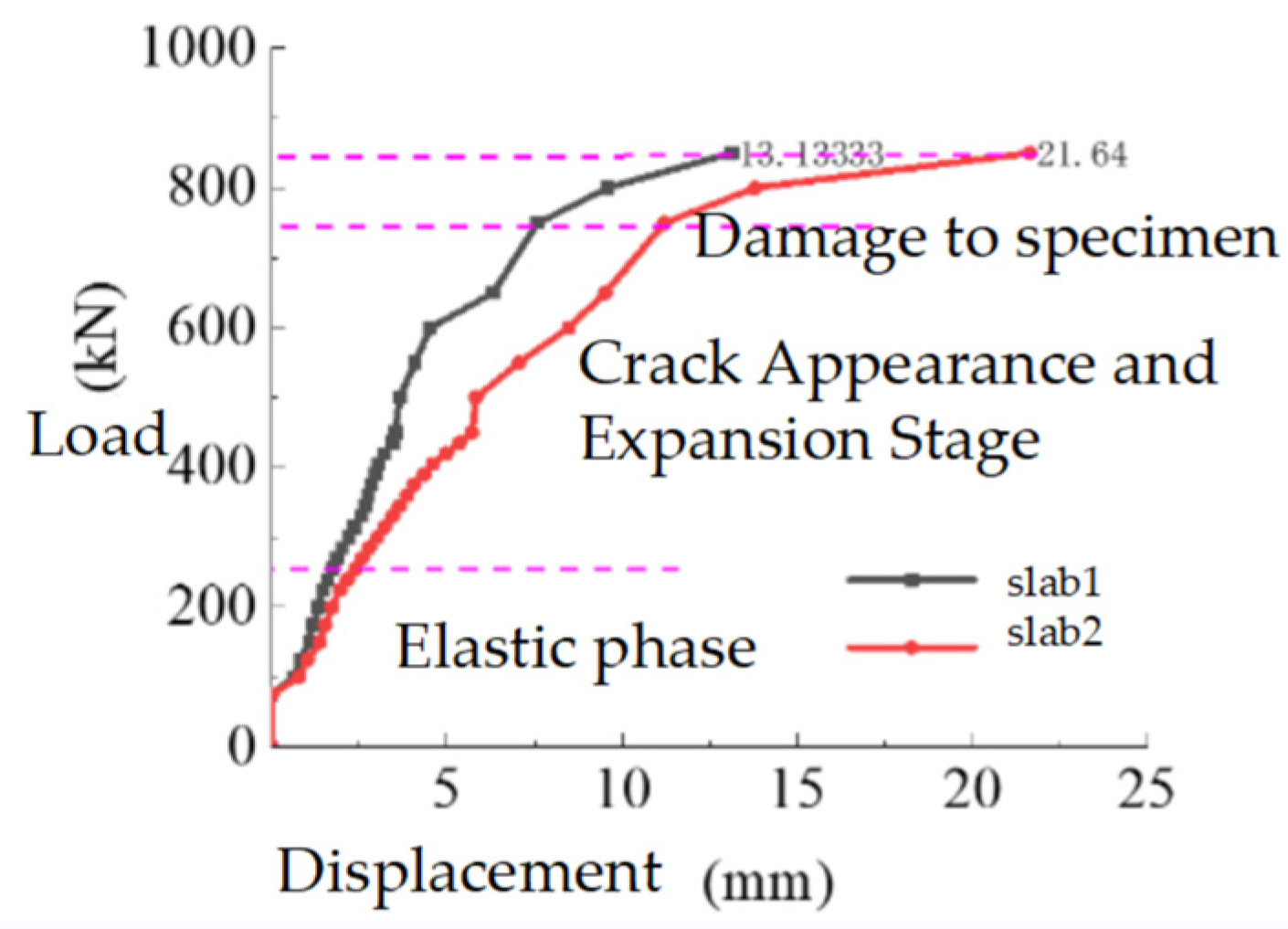
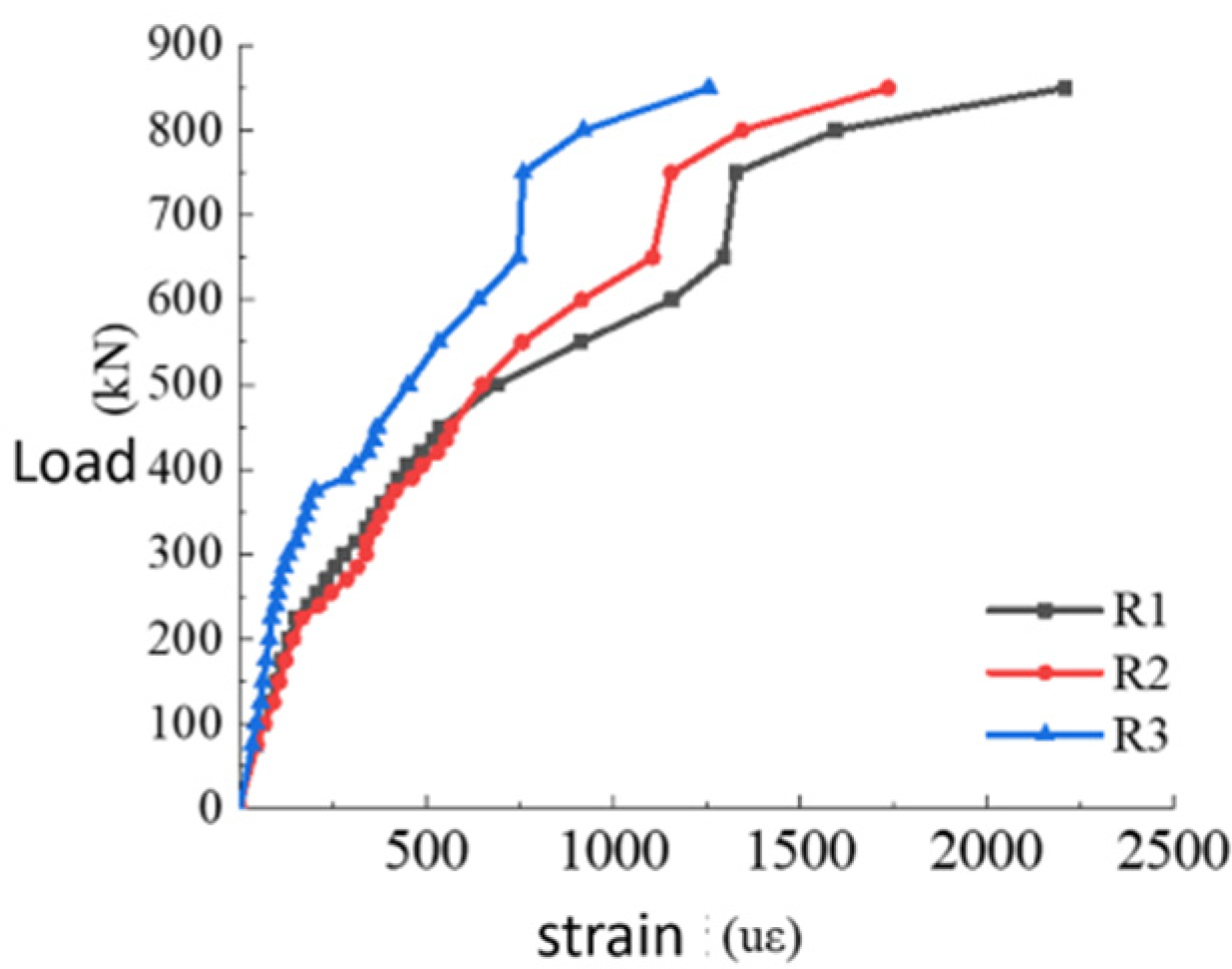
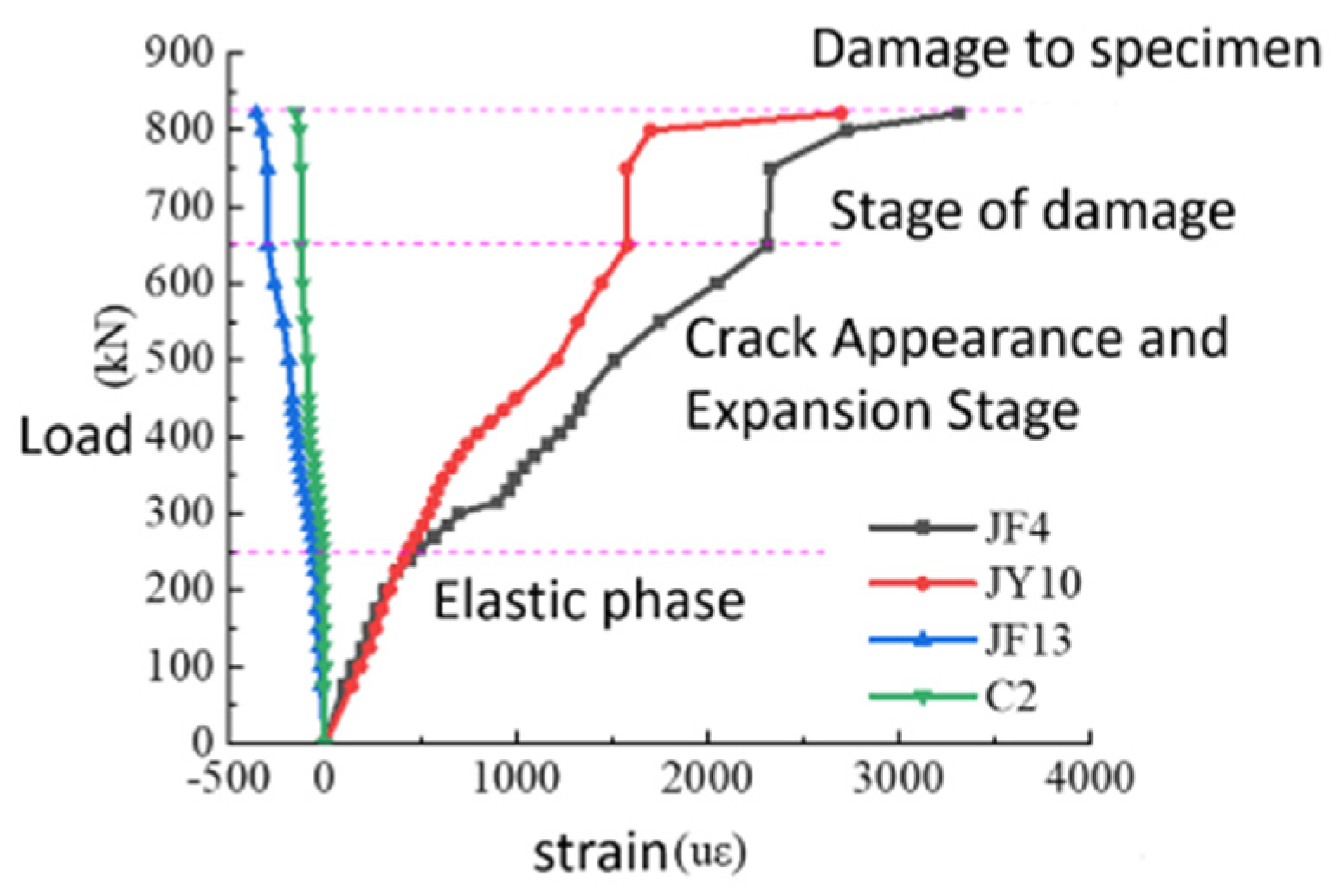

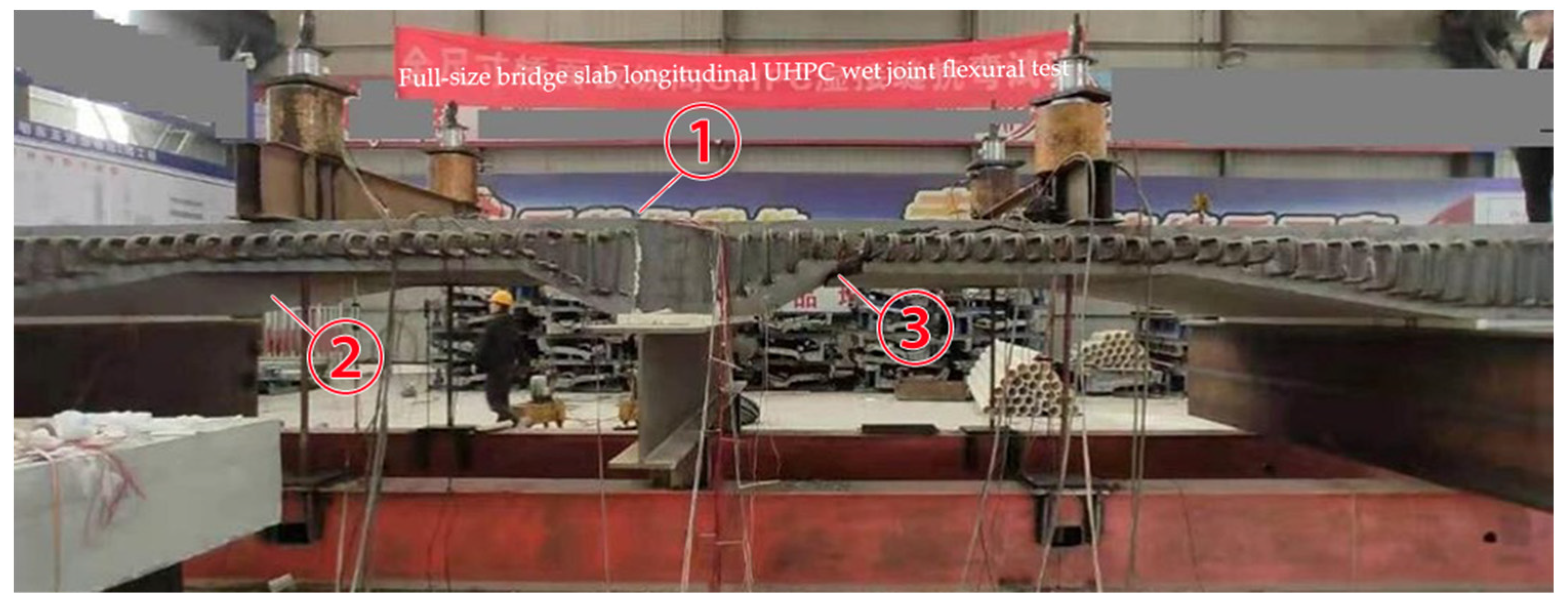


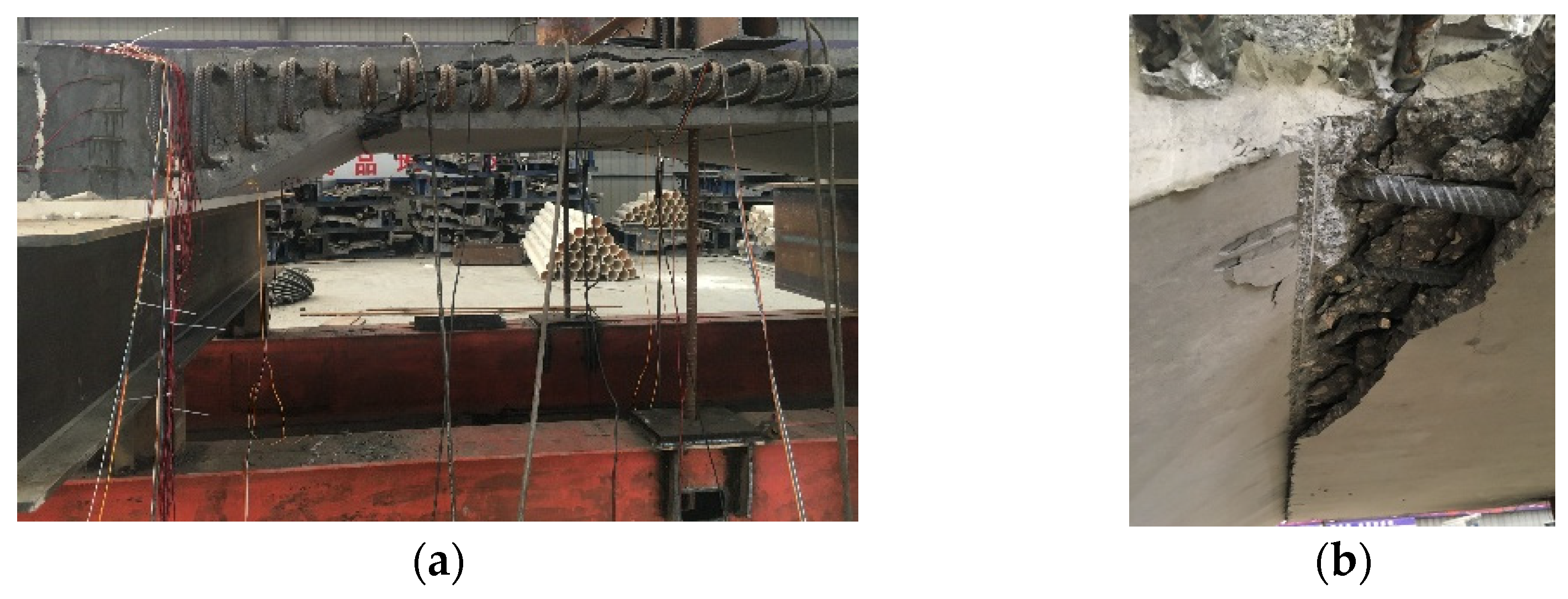

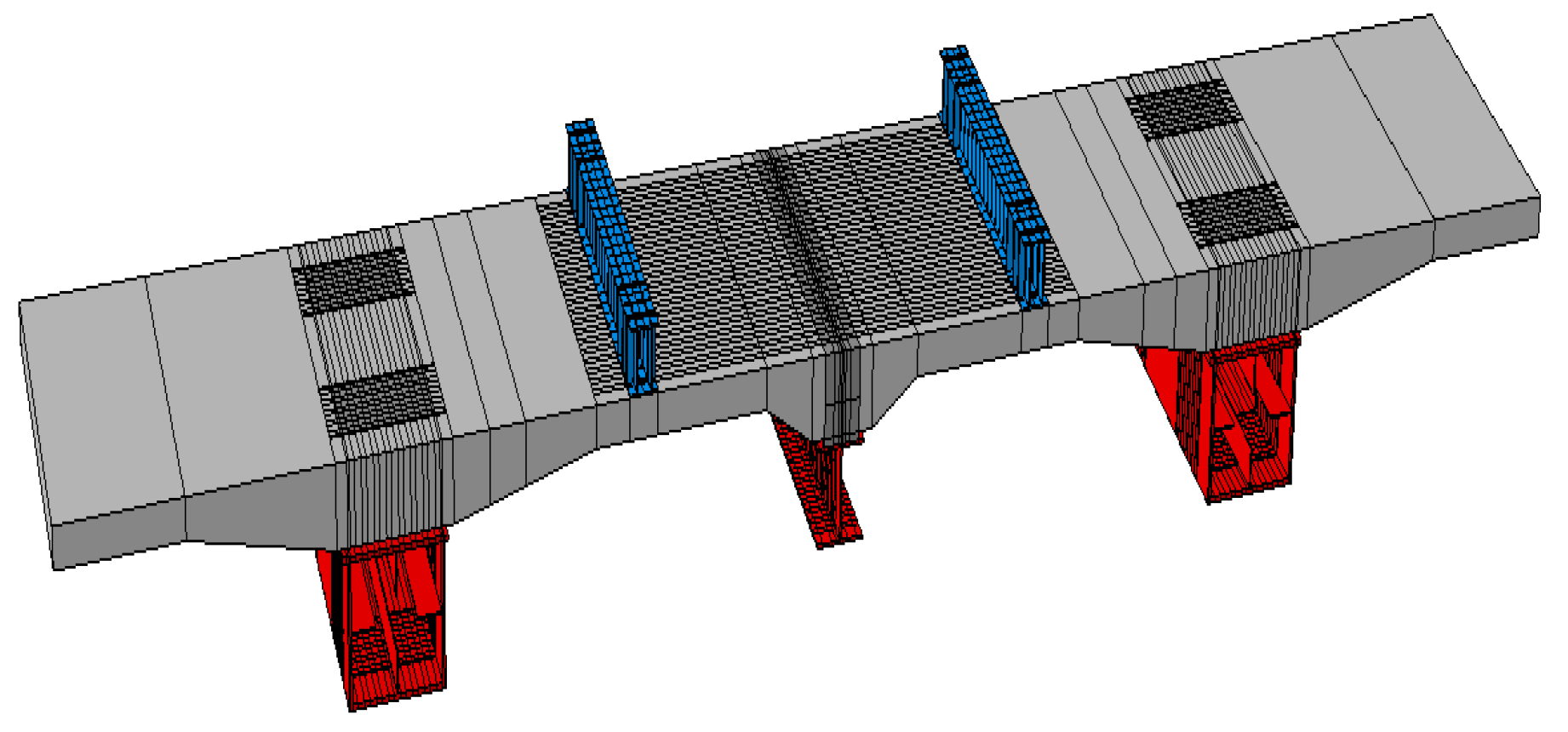

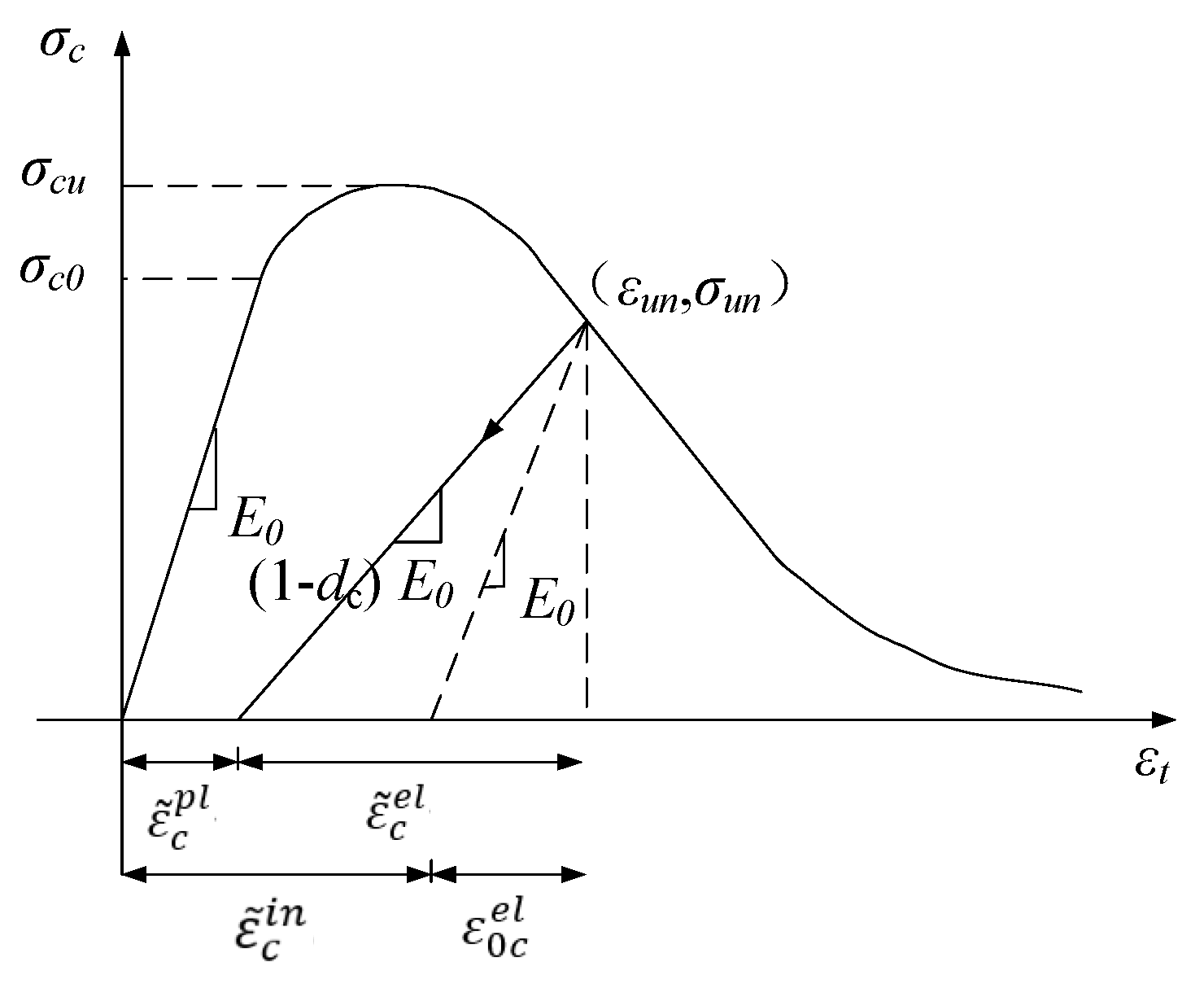
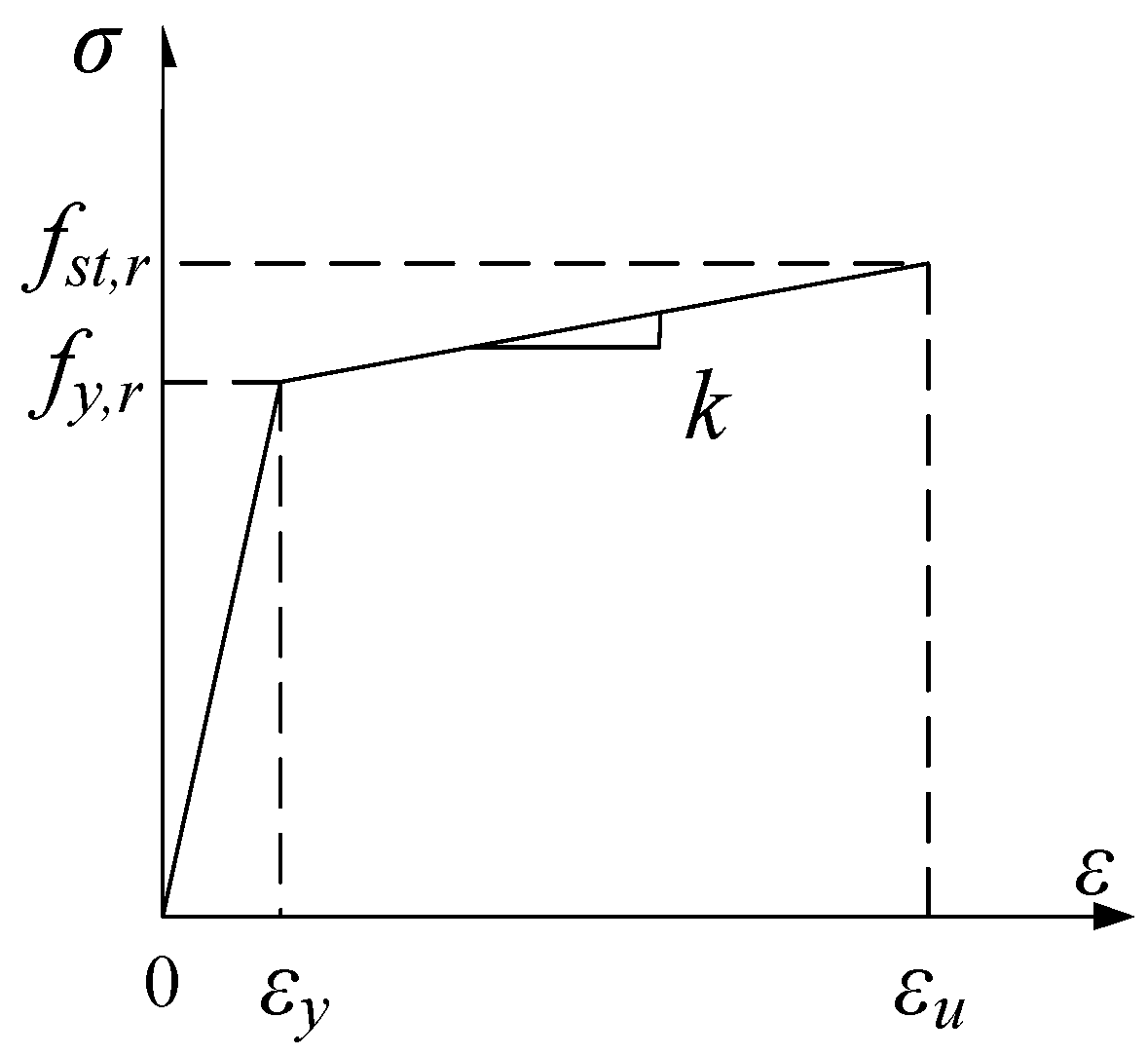
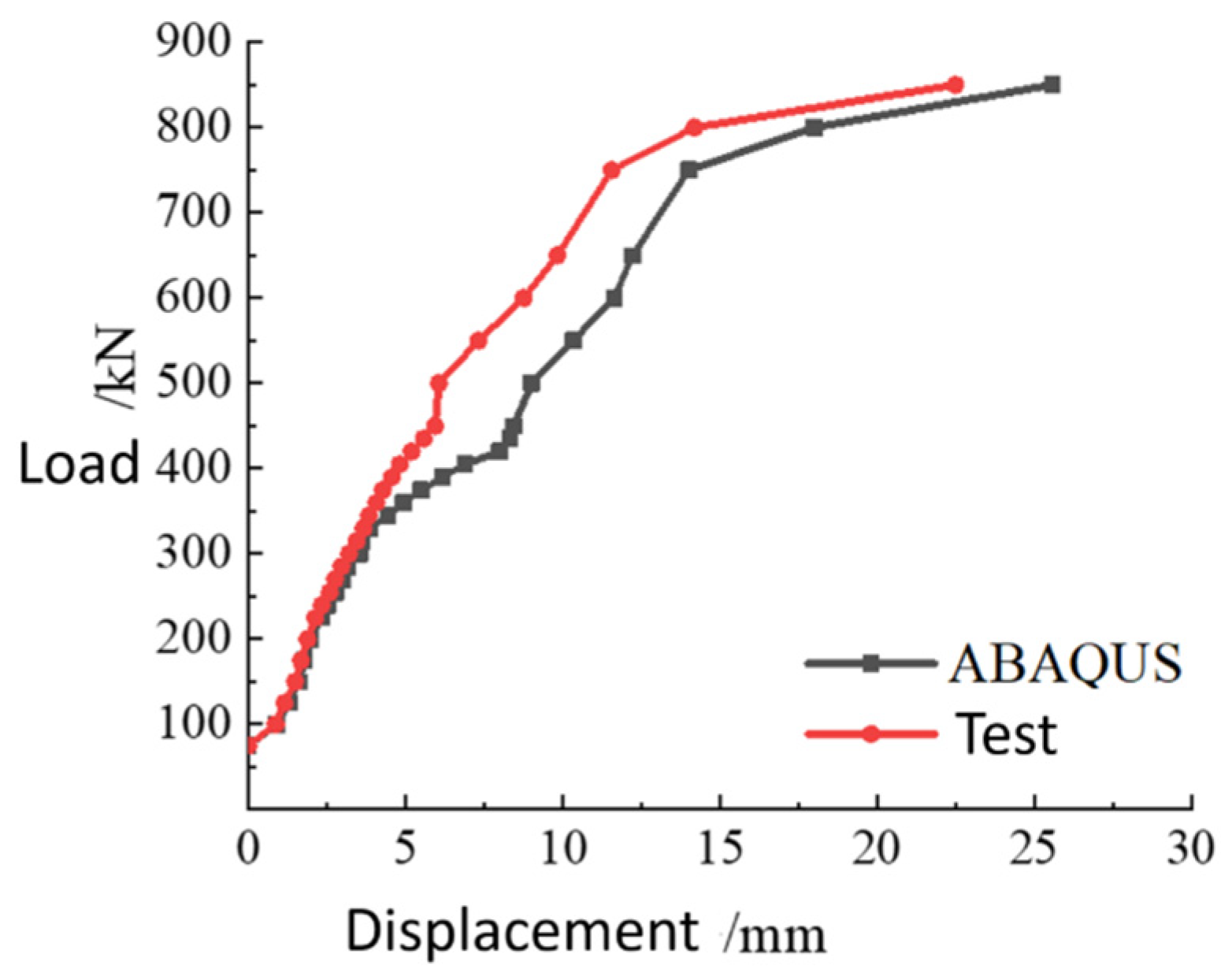

| Causality | Smoothness | Roughness | Rougher |
|---|---|---|---|
| Knn (N/mm3) | 1358 | 1358 | 1358 |
| Kss, Ktt (N/mm3) | 20,358 | 20,358 | 20,358 |
| ,, | 3.02 | 5.01 | 5.63 |
| Totle, plastic displacement (mm) | 0.018 | 0.117 | 0.241 |
Disclaimer/Publisher’s Note: The statements, opinions and data contained in all publications are solely those of the individual author(s) and contributor(s) and not of MDPI and/or the editor(s). MDPI and/or the editor(s) disclaim responsibility for any injury to people or property resulting from any ideas, methods, instructions or products referred to in the content. |
© 2024 by the authors. Licensee MDPI, Basel, Switzerland. This article is an open access article distributed under the terms and conditions of the Creative Commons Attribution (CC BY) license (https://creativecommons.org/licenses/by/4.0/).
Share and Cite
Hu, J.; Gu, Y.; Yan, J.; Sun, Y.; Huang, X. Experimental Study on Flexural Resistance of UHPC Wet Joint Precast Reinforced Concrete Bridge Deck Slabs with Variable Cross-Section. Appl. Sci. 2024, 14, 3028. https://doi.org/10.3390/app14073028
Hu J, Gu Y, Yan J, Sun Y, Huang X. Experimental Study on Flexural Resistance of UHPC Wet Joint Precast Reinforced Concrete Bridge Deck Slabs with Variable Cross-Section. Applied Sciences. 2024; 14(7):3028. https://doi.org/10.3390/app14073028
Chicago/Turabian StyleHu, Jiaqi, Yin Gu, Jinhuang Yan, Ying Sun, and Xinyi Huang. 2024. "Experimental Study on Flexural Resistance of UHPC Wet Joint Precast Reinforced Concrete Bridge Deck Slabs with Variable Cross-Section" Applied Sciences 14, no. 7: 3028. https://doi.org/10.3390/app14073028





